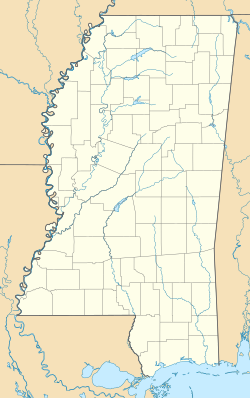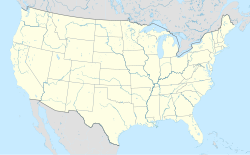Cayuga, Mississippi
Appearance
Cayuga, Mississippi | |
|---|---|
| Coordinates: 32°09′34″N 90°41′38″W / 32.15944°N 90.69389°W | |
| Country | United States |
| State | Mississippi |
| County | Hinds |
| Elevation | 269 ft (82 m) |
| Time zone | UTC-6 (Central (CST)) |
| • Summer (DST) | UTC-5 (CDT) |
| Area code | 601 |
| GNIS feature ID | 668178[1] |
Cayuga is an unincorporated community in Hinds County, in the U.S. state of Mississippi.[2]
History
[edit]Cayuga was a point on the Natchez Trace, the stop after Rocky Springs when heading northeast toward Nashville.[3] It lay within the Choctaw Nation, just outside the Anglo-Spanish colonial Natchez District.[3] The community is named after Cayuga Lake, in New York.[4] Cayuga was once home to two churches.[5] A post office called Cayuga was established in 1829, and remained in operation until 1906.[6] A variant name was "Cayuga Plantation".[2]
Notable person
[edit]- Talbert A. Luster, member of the Mississippi House of Representatives from 1912 to 1920.[7]
References
[edit]- ^ U.S. Geological Survey Geographic Names Information System: Cayuga, Mississippi
- ^ a b U.S. Geological Survey Geographic Names Information System: Cayuga
- ^ a b Rainwater, P. L. (1934). "The Autobiography of Benjamin Grubb Humphreys (August 26, 1808 – December 20, 1882)". The Mississippi Valley Historical Review. 21 (2). Organization of American Historians. Oxford University Press: 231–255. doi:10.2307/1896893. ISSN 0161-391X. JSTOR 1896893. OCLC 1776316.
- ^ Baca, Keith A. (2007). Native American Place Names in Mississippi. University Press of Mississippi. p. 20. ISBN 978-1-60473-483-6.
- ^ Rowland, Dunbar (1907). Mississippi: Comprising Sketches of Counties, Towns, Events, Institutions, and Persons, Arranged in Cyclopedic Form. Vol. 1. Southern Historical Publishing Association. p. 381.
- ^ "Post Offices". Jim Forte Postal History. Retrieved July 9, 2019.
- ^ History, Mississippi Department of Archives and (1912). The Official and Statistical Register of the State of Mississippi. Department of Archives and History. p. 413.


